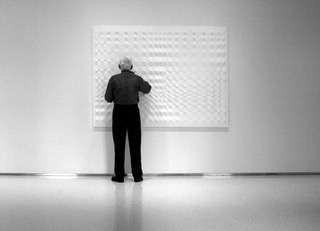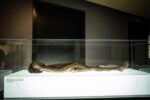Enrico Castellani – Le Superfici e i Fondamenti

LOOM gallery e Fondazione Enrico Castellani presentano, a distanza di vent’anni dall’ultima personale a Milano: “Enrico Castellani – Le Superfici e i Fondamenti”, a cura di Tommaso Trini.
Comunicato stampa
Twenty years after the artist’s last solo show in Milan, LOOM Gallery and Fondazione Enrico Castellani are pleased to present “Enrico Castellani - Le Superfici e i Fondamenti”, curated by Tommaso Trini.
The exhibition will feature a series of atypical and in some sense complementary works from different fields, helping to underscore how Castellani’s entire practice developed within a context of experimentation that ranged from architecture and engineering to mathematics and physics.
Specifically, it includes two large white triangular canvases, their surfaces animated at the center by a double row of vertical points in relief, with an equal number of depressions in between. These pieces are echoed by two massive wooden sculptures clearly inspired by ships, made from square beams stabilized by steel stays and rig- ging attached to small mooring posts. This body of works was made for the artist’s solo show at Trento’s Galleria Civica in 1999, and they have not been presented together since.
Though these pieces belong to different and seemingly distant spheres—since the first two are reliefs and shaped canvases, while the others clearly fall into the category of sculpture and installation—when presented in close dialogue with each other, in a way aptly chosen considering the possible reversal of parts, they show how Castel- lani’s entire artistic investigation revolved around concretely establishing fields of opposing forces: like two sides of the same coin, they affirm and negate each other at the same time, until an indisputable balance is reached. The tension governing the surfaces in relief is not alien to the one underpinning the sculptures.
The latter clearly reveal the structural and engineering factors and the actual process that led to their formation; like the shaped canvases, they do not present themselves as images. Eluding ordinary definitions, they expand beyond these boundaries to interact with space in a very compelling way, shaping and structuring it to highlight the part left empty, as integral to the work.
Not coincidentally, as Tommaso Trini writes in his essay on the exhibition: “Castellani’s work does not reveal itself; rather, it expands. If we have known since Heraclitus that ‘Nature loves to hide,’ and that even today cos- mologists must reckon with darkness, whether in energy or matter, we should update our languages to fit nature. Nor will an artist’s ode to light be enough to help us see clearly. Oh uncommon light of art, illuminate the discrete steps of the waves and/or particles that flow between hollows and reliefs to flood your surfaces in beauty! Build- ing on specific iconic foundations, Castellani embraces the duality of surfaces and/or inner emptiness: a violin masterfully played. These extro/intro/flexed bodies are tools of haptic observation, which seem to resonate at the touch of our eyes; frameless, they open up new fields of space and energy. The closed surfaces are in dialogue with the open foundations, like steps on the moon. The surfaces radiate more light when animated by concavities or wells that sensitize them: this was young Enrico’s pivotal insight. His art thus expanded over every dark-object surface, as well as into sculpture, installation, events, and the conceptual realm, special tangents less explored until now.”
This exhibition is organized in close collaboration with Fondazione Enrico Castellani. It is accompanied by an es- say by Tommaso Trini, which examines for the first time the implications and unknown territories contemplated by Castellani’s work: starting with the foundational principles on which his thought is based, to arrive at possible connections with other disciplines.
Enrico Castellani (1930 - 2017) graduated from architecture school in Brussels in 1956; returning to Italy in 1959, he founded the Azimut/h gallery and magazine with Piero Manzoni. In that same year, he created his first relief surface, blazing one of the most significant paths of experimentation in the postwar period. Major exhibitions of his work have been presented most recently at Fondazione Prada, Milan in 2001, Cambridge University in 2002, the Pushkin Museum, Moscow in 2005, Ca’ Pesaro, Venice and Musée d’Art Moderne, Saint-Etienne in 2013.
ENRICO CASTELLANI | LE SUPERFICI E I FONDAMENTI
INAUGURAZIONE Giovedì, 28 Ottobre, 7-9pm
MOSTRA 29 Ottobre - 31 Dicembre 2021
ORARI Martedì / Sabato, 2-7pm o su appuntamento
LOOM gallery e Fondazione Enrico Castellani presentano, a distanza di vent’anni dall’ultima personale a Milano: “Enrico Castellani - Le Superfici e i Fondamenti”, a cura di Tommaso Trini.
Per l’occasione verranno esposte opere atipiche, a tratti complementari e appartenenti a diversi ambiti, a sotto- lineare come l’intera pratica di Castellani si sia sviluppata all’interno di un contesto di ricerca nel quale dall’ar- chitettura e dall’ingegneria si passa alla matematica e alla fisica.
Nello specifico due grandi tele bianche di foggia triangolare, la cui superficie è mossa al centro da un doppio re- gistro di rilievi verticali, entro il quale si sviluppano altrettanti avvallamenti, fanno da eco alle due imponenti scul- ture lignee, di chiara ispirazione nautica, composte da travi a sezione quadrata bilanciate tra loro tramite volanti d’acciaio e sartie allocate a piccole bitte. Il corpo di lavori è stato realizzato in occasione della mostra personale alla Galleria Civica di Trento del 1999 e da allora non sono mai più stati presentati assieme.
Distinti e apparentemente distanti – appartenenti all’ambito del rilievo e della tela estroflessa i primi due elabo- rati, chiaramente riconducibili ad un contesto scultoreo, installativo e costruttivo gli altri – questi lavori, proposti in dialogo serrato e sagacemente licenziati considerando il possibile capovolgimento delle parti, mostrano come l’intera vicenda artistica di Castellani si regga sulla concreta determinazione di campi di forze opposte che, come le facce di una medaglia, si affermano e si negano simultaneamente, sino al raggiungimento dell’equilibrio indi- scutibile.
La tensione che governa le superfici a rilievo non è estranea a quella sulla quale si reggono le sculture presenta- te. Infatti rivelano chiaramente i dati costruttivi e strutturali e il processo stesso che porta alla loro formazione e, come le tele estroflesse, non si pongono in qualità di immagini, sottraendosi alle definizioni più solite, per espan- dersi oltre i limiti e relazionarsi con lo spazio in modo estremamente efficace; determinandolo e strutturandolo sino a rendere l’evidenza del vuoto parte integrante dell’opera.
Non a caso, come scrive Tommaso Trini nel saggio redatto per questa occasione: “L’opera d’arte di Castellani non si lascia scoprire, si espande. E se già Eraclito tramandò che «la natura delle cose ama celarsi», e se tutt’oggi i cosmologi valutano oscure là un’energia e qui una materia, converrà aggiornare i linguaggi secondo natura. Né basterà un’ode alla luce prodotta da tale artista a vederci chiaro. O luce d’arte alquanto rara schiarisci i passi discreti delle onde e/o particelle che irrorano tra flessioni e rilievi le tue superfici nella loro bellezza! Secondo precisi fondamenti iconici Castellani condivide la dualità di superfici e/o vuoto interno: il violino del suo presti- gio. Tali corpi estro/intro/flessi sono strumenti dell’osservare aptico, quando pare di toccarli con gli occhi e farli risuonare; senza cornici, aprono campi di spazio ed energia. Le superfici chiuse dialogano coi fondamenti aperti come passi sulla luna. Le superfici emanano più luce se animate da cavità o fondali che le sensibilizzano, fu questo l’atout del giovane Enrico. La sua arte è perciò espansa sia in ogni singola superficie a corpo oscuro, tra sculture, ambienti, eventi, concetti, excursus di pregio, finora meno frequentati.”
La mostra, realizzata in stretta collaborazione con la Fondazione Enrico Castellani, è accompagnata da un testo di Tommaso Trini nel quale, per la prima volta, vengono considerate le implicazioni e lo sconfinamento in ambiti ignoti che il lavoro di Castellani contempla; partendo dalle fondamenta sulle quali si regge il suo pensiero e arri- vando a considerare le possibili connessioni con altre discipline.
Enrico Castellani (1930 - 2017) nel 1956 si laurea in architettura a Bruxelles; rientrato in Italia nel 1959 fonda la rivista e la galleria Azimut/h con Piero Manzoni. Nello stesso anno realizza la prima superficie a rilievo dando vita ad una delle esperienze più significative del dopoguerra. Tra le esposizioni più importanti degli ultimi anni sono da ricordare quelle alla Fondazione Prada a Milano nel 2001, all’Università di Cambridge nel 2002, al Puskin Museum di Mosca nel 2005, a Ca’ Pesaro a Venezia e al Mesée d’Art Moderne a Saint-Etienne nel 2013.



